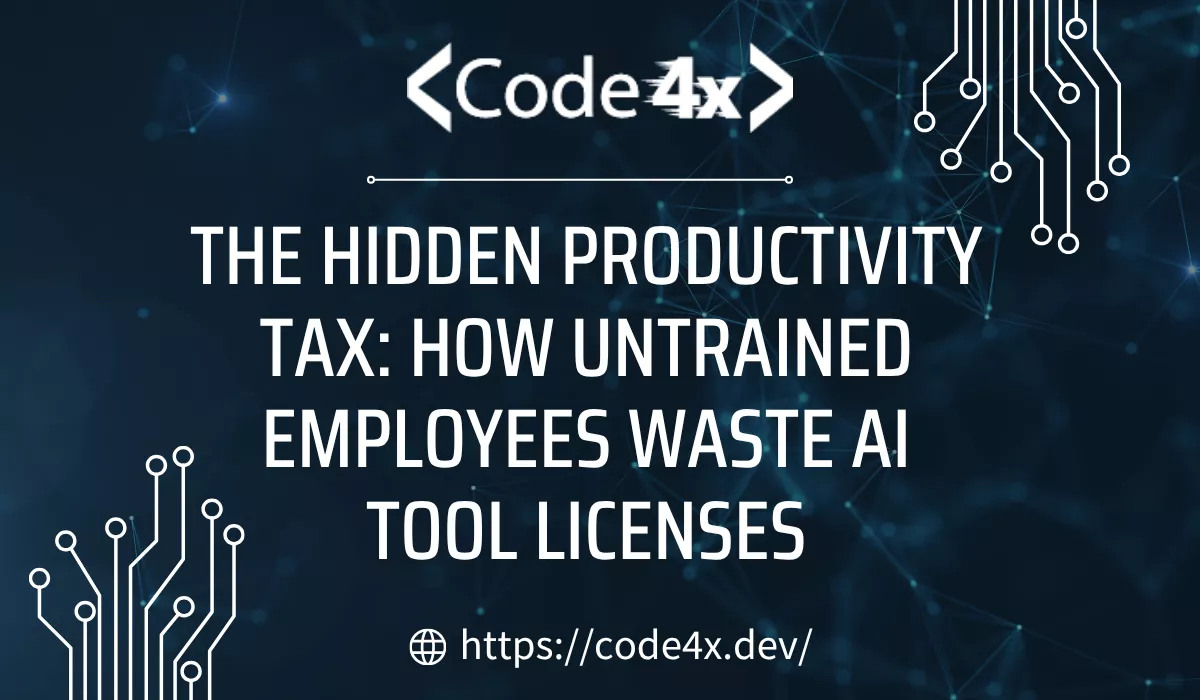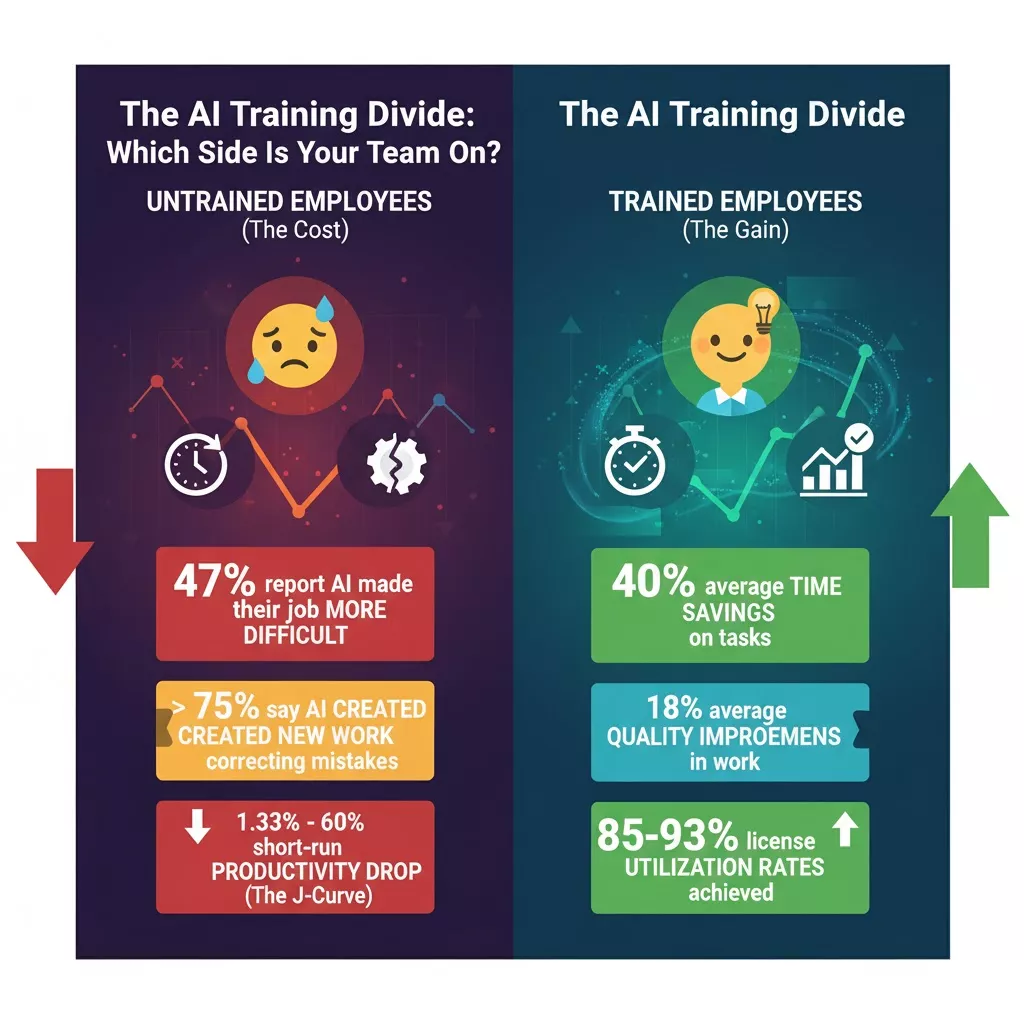
The Hidden Productivity Tax: How Untrained Employees Waste AI Tool Licenses
- Categories Blog
- Date October 27, 2025
In boardrooms across the globe, CFOs are approving massive investments in generative AI tools. Microsoft Copilot licenses at $30 per user per month. ChatGPT Enterprise subscriptions. Google Gemini for Workspace. The promises are compelling: 40% productivity gains, 3.7x ROI, transformative business outcomes. With AI spending projected to reach $644 billion in 2025—a staggering 76% increase from the previous year—no organization wants to be left behind.
But here’s the uncomfortable truth that’s emerging from enterprise data centers: Companies are hemorrhaging millions of dollars on AI licenses that sit largely unused, misused, or underutilized by untrained employees.
This isn’t a technology problem. It’s a training crisis masquerading as digital transformation.
The Staggering Scale of AI License Waste
The numbers tell a sobering story. While enterprises rush to deploy AI tools, the average company now interacts with 254 distinct AI applications. Yet adoption rates reveal a troubling disconnect between investment and utilization.
Consider these findings: Only 39% of AI users receive workplace training. Meanwhile, 45% of workers admit they’ve used banned AI tools at work, and 45.4% of sensitive AI interactions come from personal email accounts—not corporate-sanctioned systems. This shadow AI phenomenon represents both a security nightmare and a financial black hole.
The average enterprise wasted $18 million on unused software applications last year, even as overall SaaS spending declined. Companies leave more than half of licensed SaaS applications completely unused, yet continue adding six new applications monthly. With AI tools layered on top of this existing waste, the financial bleeding intensifies.
Marcus McGehee, founder of AI Consulting Lab, frames the issue bluntly: “The true cost of AI isn’t just the license fee; it’s the fee plus the missed opportunity that comes with untrained employees and untapped potential”. When frontier AI companies require year-long commitments and minimum license quantities, every unused seat becomes a recurring drain on capital.
AI Training Built for Real World Use
Contact UsThe Hidden Costs Beyond the License Fee
CFOs evaluating AI investments typically focus on direct costs: licenses, infrastructure, and implementation. But the hidden expenses dwarf these visible line items.
The Opportunity Cost of Underutilization
A medical device company discovered their “AI success story” actually masked profound inefficiency: a marketing manager spent six hours getting ChatGPT to write a product announcement, then another four hours fixing the off-brand, regulatory-noncompliant output. That’s 10 hours of highly paid professional time to produce work that trained employees accomplish in a fraction of the time. Multiply this across thousands of employees, and the productivity tax becomes staggering.
Research demonstrates that properly trained employees using AI achieve 40% time savings and 18% quality improvements. Yet without training, the inverse occurs: 47% of employees report AI has made aspects of their job more difficult and added to their workload. More than 75% of workers say AI created new work correcting its mistakes rather than reducing burden.
The Compliance and Security Tax
The shadow AI crisis exposes organizations to financial penalties that can exceed the entire AI budget. When a customer service representative accidentally shared patient medical information in an AI prompt, the potential HIPAA violation could have cost millions in fines and remediation. These aren’t theoretical risks—they’re documented incidents at major corporations.
Samsung banned ChatGPT and similar tools after employees leaked sensitive internal information. Several banks followed with similar restrictions. Yet banning tools without providing trained alternatives simply drives shadow usage deeper underground, where it’s even harder to monitor and control.
The financial implications compound: 58% of employees have posted sensitive data into AI tools, including client records, financial data, and internal documents. With 80% of workers classifying their AI understanding as only beginner or intermediate, most don’t recognize when they’re creating compliance violations until after the damage occurs.
The Productivity Paradox
Perhaps most frustrating for CFOs is the productivity paradox: AI investments that should boost output actually reduce it in the short term. Research on AI adoption in manufacturing firms found that organizations adopting AI experienced a 1.33 percentage point drop in productivity. When correcting for selection bias, the short-run negative impact jumped to approximately 60 percentage points.
This J-curve effect isn’t merely growing pains. It reflects fundamental misalignment between powerful new tools and the human systems required to operate them effectively. Without training, data infrastructure, and workflow redesign, even advanced AI creates bottlenecks rather than breakthroughs.
Why Training Makes the Difference
The contrast between trained and untrained AI users illuminates exactly where the hidden productivity tax originates.
Quantified Training Impact
Organizations implementing comprehensive AI training programs see dramatically different outcomes than those pursuing tool-only strategies:
- 14-40% productivity gains for trained employees versus productivity losses for untrained workers
- 3-5x higher financial returns on AI investments when training accompanies tool adoption
- 85-93% utilization rates achieved through structured training programs versus single-digit adoption for untrained populations
A healthcare customer care team that received just six hours of AI training achieved remarkable results: each employee saved 8 hours weekly, customer satisfaction increased 11%, revenue grew 6%, and the organization realized 616% ROI in 60 days with projected annual ROI of 1,628%.
Insight Enterprises achieved 93% Microsoft Copilot utilization rates within three months of implementing comprehensive training. The company responded to customer RFPs 50% faster and established itself as the premier Copilot partner in Canada. Their success stemmed not from superior technology—every organization has access to the same tools—but from superior training.
Breaking the Shadow AI Cycle
The shadow AI phenomenon—employees using unauthorized tools to circumvent official systems—directly results from inadequate training on approved platforms. When 40% of workers say they’d knowingly violate company policy to finish tasks quicker, the message is clear: official tools aren’t meeting their needs because they don’t know how to use them effectively.
PwC’s company-wide AI training initiative generated an estimated $1.5 billion in additional revenue over six months. The gains came not from AI replacing workers but from AI-enhanced employees delivering services faster, with greater accuracy and innovation. Trained employees could identify and capitalize on revenue-generating opportunities that untrained staff missed entirely.
The CFO's Framework for Maximizing AI ROI
Forward-thinking CFOs recognize that AI license costs represent only the entry fee. The real value—or waste—materializes based on human capital development.
1. Measure True Utilization, Not Just Seat Count
Most organizations track license purchases but not actual usage. Enterprise AI tools include admin dashboards showing active users, session frequency, and usage patterns. Track the percentage of employees actively using AI tools and monitor adoption trends over time.
Zapier’s internal tracking revealed AI adoption climbed from 63% in late 2023 to 97% by 2024. This granular visibility enabled targeted interventions for lagging teams and justification for expanded investment in high-performing areas.
2. Calculate the Full Cost of Non-Adoption
Build financial models that capture:
- Direct license costs for unused seats
- Opportunity costs of productivity gains not realized
- Compliance risks and potential penalties from shadow AI
- Competitive disadvantage as trained rivals pull ahead
- Employee turnover costs when AI-frustrated talent leaves
One analysis found AI specialists command $175,000-$350,000 annually, yet 67% of companies report severe AI talent shortages. When expensive hires discover the organization lacks infrastructure and training to succeed, they leave within nine months. The revolving door of talent represents another hidden tax.linkedin
3. Invest in Role-Specific Training Programs
Generic AI training fails because different roles require different competencies. Effective programs provide:
- Foundational AI literacy for all employees to understand capabilities and limitations
- Prompt engineering tailored to specific business functions (sales, marketing, customer service, finance)
- Hands-on workshops demonstrating relevant use cases for each department
- Ongoing coaching and peer training to embed AI in daily workflows
Culture Amp’s research shows managers set the tone for AI adoption. When 90% of sales representatives use AI but only 40% of sales managers do, the gap signals leadership isn’t championing the tools. Training programs must prioritize managers and create cascading adoption through teams.
4. Establish Governance Without Stifling Innovation
The solution to shadow AI isn’t prohibition—it’s providing better alternatives through training. Develop clear policies on approved tools, data handling, and security requirements, then train employees thoroughly on compliant usage.
NASA and the Interior Department created prompt scripts tailored to various business lines, showing staff exactly how to use AI tools in their specific roles. This practical guidance accelerated adoption while maintaining security and governance standards.
Don’t Pay for AI Tools That No One Knows How To Use — Fix It Now
Contact Us5. Stage Investments with Clear ROI Gates
Rather than enterprise-wide rollouts, implement AI in phases with defined success metrics at each gate:
Proof phase: Small pilot with intensive training, measuring productivity gains
Pilot phase: Department-level deployment with sustained training support
Scale phase: Enterprise rollout only after demonstrating positive ROI in pilots
Set conservative targets—18-month payback periods and measurable efficiency gains. Kill switches at each gate prevent runaway spending on ineffective implementations.
The Competitive Imperative
The AI training gap creates widening competitive moats. Organizations that train effectively compound their advantages quarterly, while those purchasing tools without training fall further behind despite spending similar amounts.
McKinsey estimates generative AI could add $2.6 trillion to $4.4 trillion annually to the global economy. This value won’t distribute evenly. It will concentrate among organizations that develop AI-literate workforces capable of capturing the productivity gains.
Studies show 75% of C-suite leaders now rank AI in their top three priorities. But 92% of AI initiatives have paid for themselves only when organizations invested in comprehensive training alongside technology. The 8% that failed? They bought licenses without building capabilities.
Recent research from MIT and Harvard proves the training effect conclusively. When highly skilled consultants received GPT-4 access along with training, they achieved 38% performance increases and completed 12.2% more tasks. Customer support agents with AI training improved productivity by 14% on average, with novice workers seeing 34% gains.
These aren’t marginal improvements. They represent the difference between profit and loss, between market leadership and irrelevance.

How code4x.dev Eliminates the Hidden Productivity Tax
At code4x.dev, we’ve built our corporate training services specifically to address the AI adoption crisis plaguing enterprises worldwide. We understand that your AI investments are only as valuable as your employees’ ability to leverage them effectively.
Our Approach Delivers Measurable ROI
Unlike generic training vendors, we design programs specifically for productivity improvement and license optimization:
- Use Case-Driven Curriculum: We identify the highest-value applications of your AI tools within your specific business context, ensuring every training hour translates to measurable output gains
- Role-Specific Enablement: Finance teams, procurement professionals, operations staff, and executives each receive targeted training relevant to their daily workflows—not theoretical overviews
- Rapid Time-to-Value: Our accelerated programs achieve 70%+ adoption rates within 90 days, eliminating the hidden tax of underutilization from day one
- Governance Integration: We embed security, compliance, and data handling best practices directly into training, shutting down shadow AI while accelerating approved tool usage
Proven Results Across Industries
Our clients achieve the productivity gains and cost savings the AI vendors promise:
- 30-50% reduction in time spent on repetitive tasks through proper prompt engineering and workflow optimization
- 80%+ active user rates on previously underutilized enterprise AI licenses
- Elimination of shadow AI risks through comprehensive approved-tool training
- 6-12 month payback periods on combined training and license investments
Previous post
The Marketing Revolution: How Sarah Turned Her Struggling Campaign into a $2M Revenue Machine with AI Automation
You may also like



